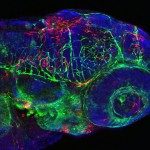Lien vers Pubmed [PMID] – 8666670
J. Cell Biol. 1996 May;133(4):853-63
Glial fibrillary acidic protein (GFAP) is an intermediate filament protein expressed predominantly in astrocytes. The study of its expression in the astrocyte lineage during development and in reactive astrocytes has revealed an intricate relationship with the expression of vimentin, another intermediate filament protein widely expressed in embryonic development. these findings suggested that vimentin could be implicated in the organization of the GFAP network. To address this question, we have examined GFAP expression and network formation in the recently generated vimentin knockout (Vim-) mice. We show that the GFAP network is disrupted in astrocytes that normally coexpress vimentin and GFAP, e.g., those of the corpus callosum or the Bergmann glia of cerebellum. Furthermore, Western blot analysis of GFAP protein content in the cerebellum suggests that posttranslational mechanisms are implicated in the disturbance of GFAP network formation. The role of vimentin in this process was further suggested by transfection of Vim-cultured astrocytes with a vimentin cDNA, which resulted in the normal assembly of the GFAP network. Finally, we examined GFAP expression after stab wound-induced astrogliosis. We demonstrate that in Vim- mice, reactive astrocytes that normally express both GFAP and vimentin do not exhibit GFAP immunoreactivity, whereas those that normally express GFAP only retain GFAP immunoreactivity. Taken together, these results show that in astrocytes, where vimentin is normally expressed with GFAP fails to assemble into a filamentous network in the absence of vimentin. In these cells, therefore, vimentin appears necessary to stabilize GFAP filaments and consequently the network formation.

